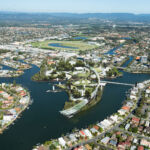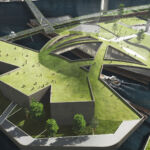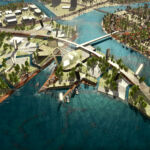Gold Coast Cultural Precinct - Innovative Design by Studio CTC
Project's Summary
The Gold Coast Cultural Precinct represents a groundbreaking architectural vision set in the heart of Gold Coast, Australia. Developed by the esteemed Studio Cachoua Torres Camilletti, this project emerged from an international competition that attracted some of the most prestigious architectural firms in the world, including Pritzker Prize winners. It encompasses a variety of cultural facilities, such as a museum, cinema, theater, workshop spaces, a library, and shops, all harmoniously integrated into a lush park environment surrounded by tranquil waterways.

At the core of the design is a main building that resembles a grassy mound, seamlessly blending with the natural landscape. This innovative structure not only serves functional purposes but also enhances the aesthetic appeal of the park. The design includes an artificial channel that divides the park and provides a pedestrian walkway, creating accessible routes for visitors to engage with the various activities and amenities offered. Additionally, Studio CTC has incorporated large screens throughout the park, acting as 'digital portals' that keep users informed about exhibitions and events while enabling real-time connections with locations around the globe.

Sustainability is a key consideration in the Gold Coast Cultural Precinct. The project features strategically placed 'generators' throughout the park, designed to meet basic sustainability needs, including recycling areas, eco-friendly restrooms, and Wi-Fi access points. These structures utilize a distinctive mesh based on Thiessen polygons and Voronoi diagrams, exemplifying a modern approach to architectural design that prioritizes environmental responsibility while enhancing user experience.

Connections are paramount in architectural design, impacting urban, transport, and structural dynamics. This project acknowledges the importance of these connections by establishing a network of 'nodes' that facilitate the integration of various functions within the precinct. By thoughtfully organizing urban space and defining the placement of these nodes, Studio CTC has created an organic flow that encourages community interaction and fosters a sense of ownership among users. This innovative approach transforms the precinct into a vibrant hub of activity and engagement.

Furthermore, the project introduces a new water route, enhancing the natural beauty of the area while promoting alternative transportation methods. This channel not only provides aesthetic value but also enriches the experience for those navigating the precinct. The design includes multi-level connections for pedestrians, cyclists, and watercraft, deliberately minimizing automobile access to ensure a peaceful environment. The central building acts as a vital link connecting the two primary sections of the precinct, embodying the essence of connectivity and community engagement in contemporary architecture.
Read also about the Devonshire Mews West - Luxury Living by Woldon Architects project






